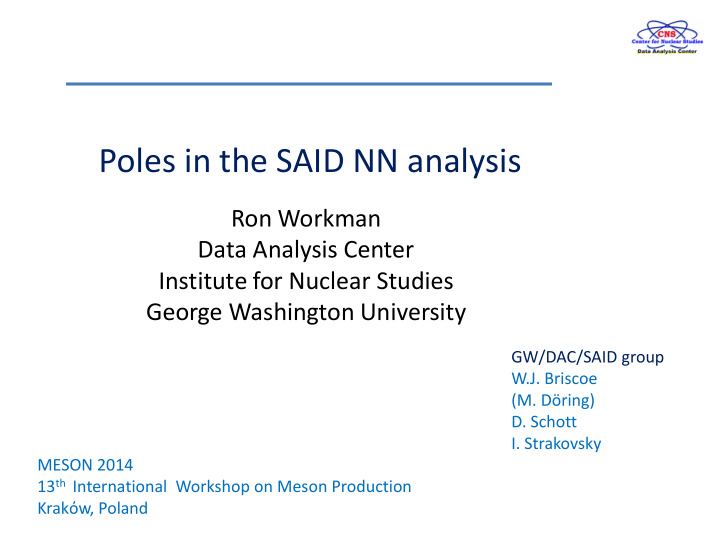



Poles in the SAID NN analysis Ron Workman Data Analysis Center Institute for Nuclear Studies George Washington University GW/DAC/SAID group W.J. Briscoe (M. Döring) D. Schott I. Strakovsky MESON 2014 13 th International Workshop on Meson Production Krak ό w, Poland
Why have an NN talk at the MESON conference?
This d * , assumed to be a I(J P )=0(3 + ) state, is motivated by: The “Inevitable” nonstrange dibaryon [ T. Goldman et al., PRC39, 1889 (1989) which has these quantum numbers. A number of very early and recent quark models predicting this state [ see M. Bashkanov, S.J. Brodsky, and H. Clement, PLB727, 438 (2013) ] Appearance in the 3-body calculation of A. Gal , H. Garcilazo, PRL 111, 172301 (2013) Does it appear in the analysis of np scattering data? The d * appears to have a mass of about 2.37 GeV and a width of about 70 MeV not seen in the published SAID fit (2007). New data are now becoming available
New pp A y data from COSY suggest improvements to SAID NN PWA (SP07) may be necessary Preliminary COSY-ANKE data : red/blue + selected older data versus SP07 and a re-fit (red)
New np A y data from COSY suggest improvements to SAID NN PWA (SP07) may be necessary COSY-WASA data : red + selected older data versus SP07 and a Revised re-fit (red) fit SP07
SAID fit of new np A y data from COSY-WASA See Arndt et al., PRD35,128(1987 ) (exchange) K-matrix elements have appropriate left-hand cuts, 1- π exchange. (production) K-matrix elements Uncoupled ( 3 F 3 ) are polynomials – the Chew- Mandelstam function gives the right-hand cuts. Coupled ( 3 D 3 – 3 G 3 )
Poles have appeared in previous NN analyses
1 D 2 large residue, very near N Δ branch point (2148 – i 50) MeV
`On Pseudoresonances: Nonresonant Argand Loops’, B.L.G.Bakker et al ., Nuovo Cimento 19, 265 (1977)
Box diagram may produce `resonance- like’ behavior in Fig. 3 of Bakker et al . NN , KN, or π N Compare 1 D 2 pole: (2148 – i 63) MeV N Δ : (2148 – i 50) MeV to N(1440) pole: (1359 – i 81) MeV πΔ : (1349 – i 50) MeV
Notation:
Revised NN fit including COSY-WASA data ● WASA data chi-squared (SP07) before fitting ~ 1300/68 data ● Included data: 1108, 1125, 1135, 1139, 1171, 1197 MeV ● Fit, start on SP07. Result: [ 1108, 1125, 1139, 1171, 1197 MeV ] chi-square ~ 1.8/datum [ 1135 MeV ] chi-square ~ 25/datum ● Forced fit [ 1135 MeV ] cut errors/4 , add parameters coupling to the inelastic channel. Result: much better fit to 1135 MeV set - also better fit to other ‘unforced’ COSY -WASA sets, older data reproduced. ● Significant change to 3 D 3 - 3 G 3 waves, minor changes to others. ● Re-fit, new parameterization, no data weighting, gave qualitatively similar results
SP07 Fit to other quantities remains of similar quality - in some cases the revised fit is better Revised fit 1.135 GeV
Few data beyond 1.3 GeV 3 D 3 develops resonant shape 3 G 3 modified, but does not ( hints from SP07 SE fits ) have resonance-like shape
Fit will be added to allow comparisons with existing data, other fits, as well as predictions for new measurements
Summary ● To accommodate a rapid change in np A y data, over a narrow energy range, an SP07 re-fit generates a pole ● pole parameters [ 2380 ± 10 ] – i [40 ± 5 ] MeV are consistent with earlier estimates ● Structure is unfortunately near the limit of substantial coverage for np scattering data ● Narrow structures can also be interference effects [ recall discussion of narrow structure in γd →η n(p) and N(1685) ] This should also be investigated.
Comparison to old SU(6) model Dyson, Xuong 1964 Predict NN poles D 12 2176 MeV 2148 MeV A = 1876 MeV B = 50 MeV D 03 2376 MeV 2380 MeV
~2150 MeV ~2310 MeV ~2460 MeV NN π π N Δπ ΔΔ Goldman et al Yuan et al (1989) (1999)
Recommend
More recommend